Rethinking City Classification System in Vietnam: Towards Urban Sustainability and People-Centered Development
This paper presents an original attempt to bring forward extended perspectives about the
City Classification System (CCS) in Vietnam. For many years, the CCS has played a central role
the development of Vietnam national urban system as well as a motivating guideline for individual
cities. However, (1) aspects of sustainable urban development are underrepresented among the CCS
indicators and (2) the CCS remains a top-down, rigid policy which takes away much of the local
development context and their developmental challenges. It is argued that Vietnam CCS needs
adjusting to better reflect the multi-dimensional nature of urban development process (especially
sustainability) and to better comprehend people-oriented, local development.
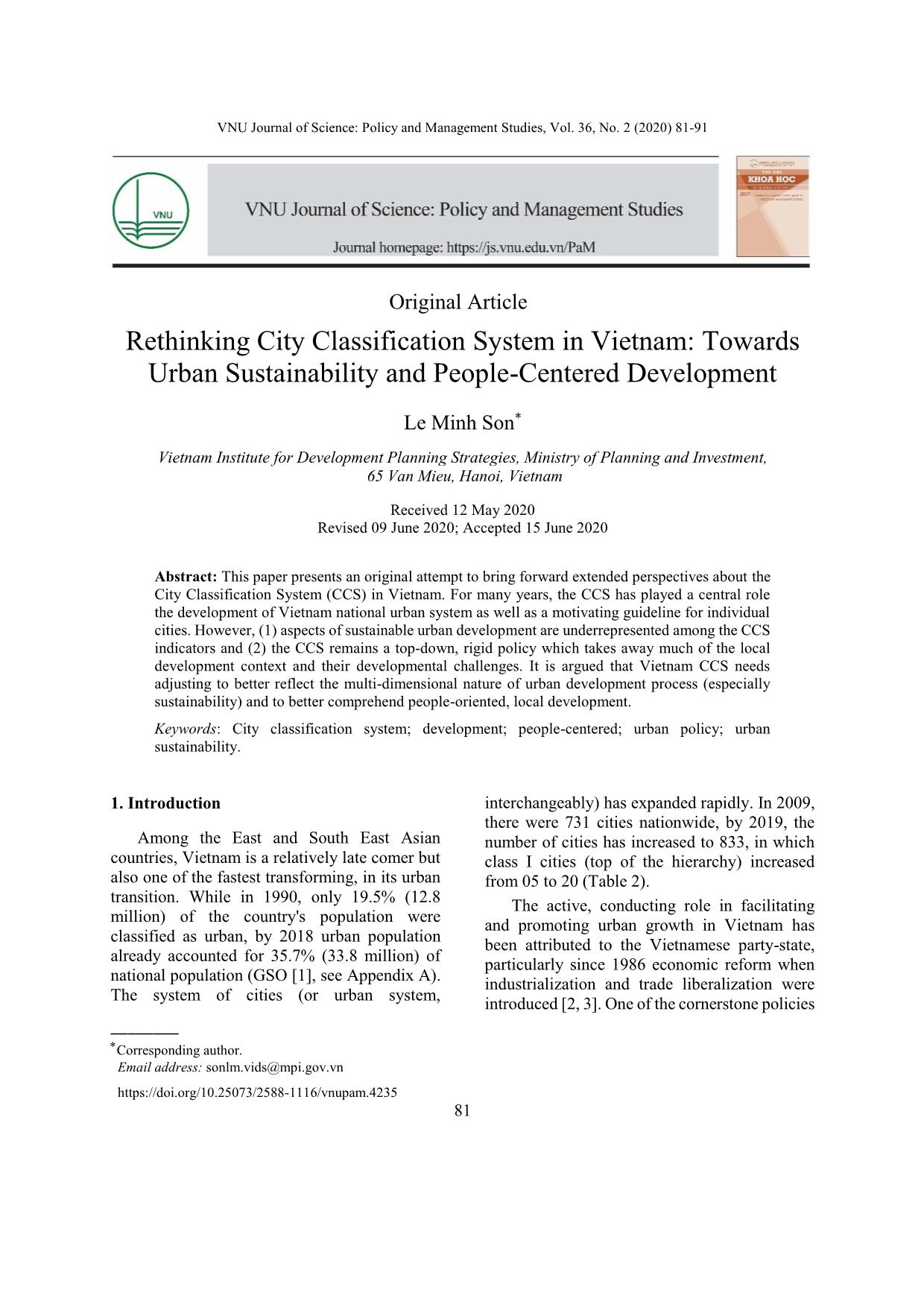
Trang 1
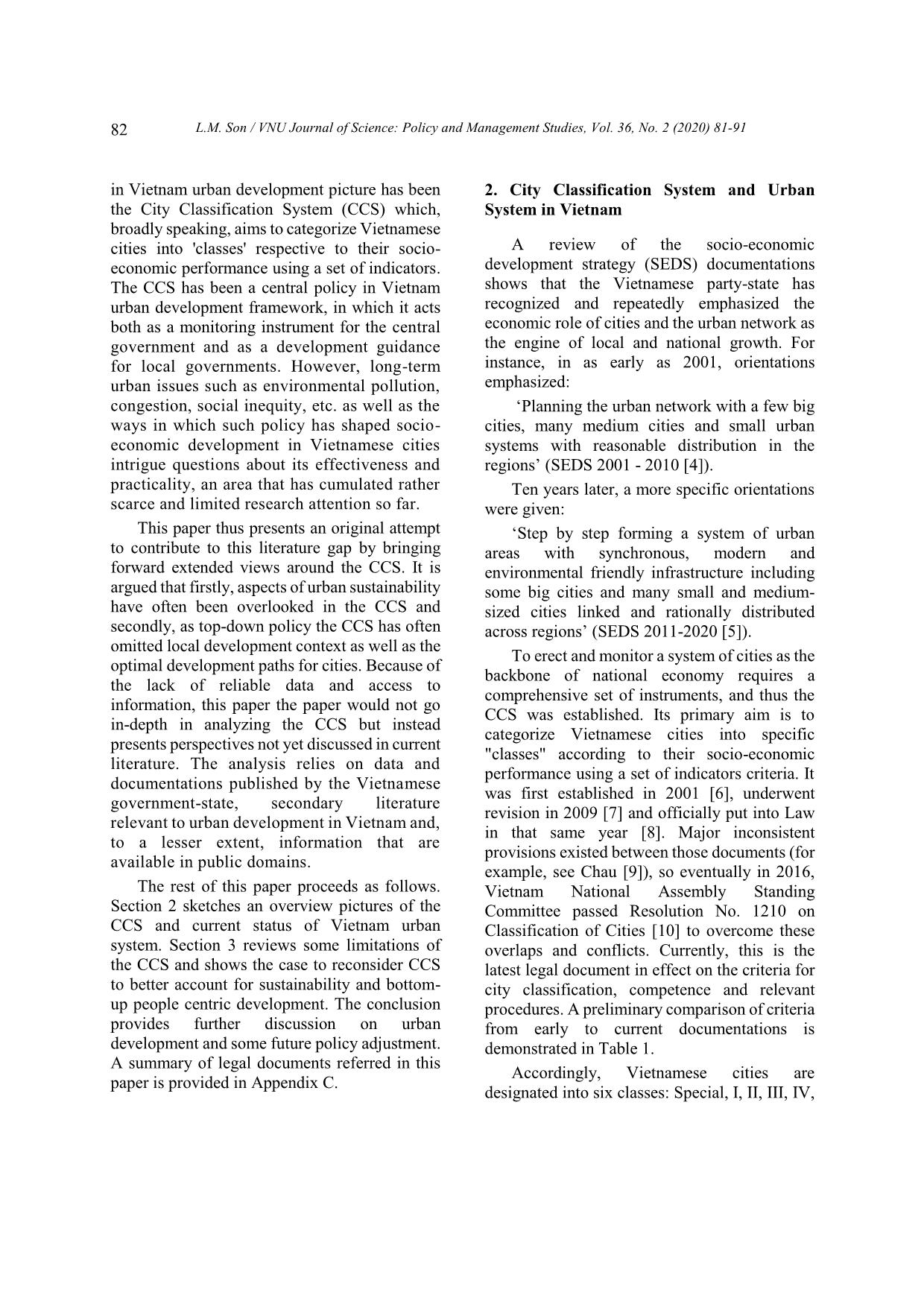
Trang 2
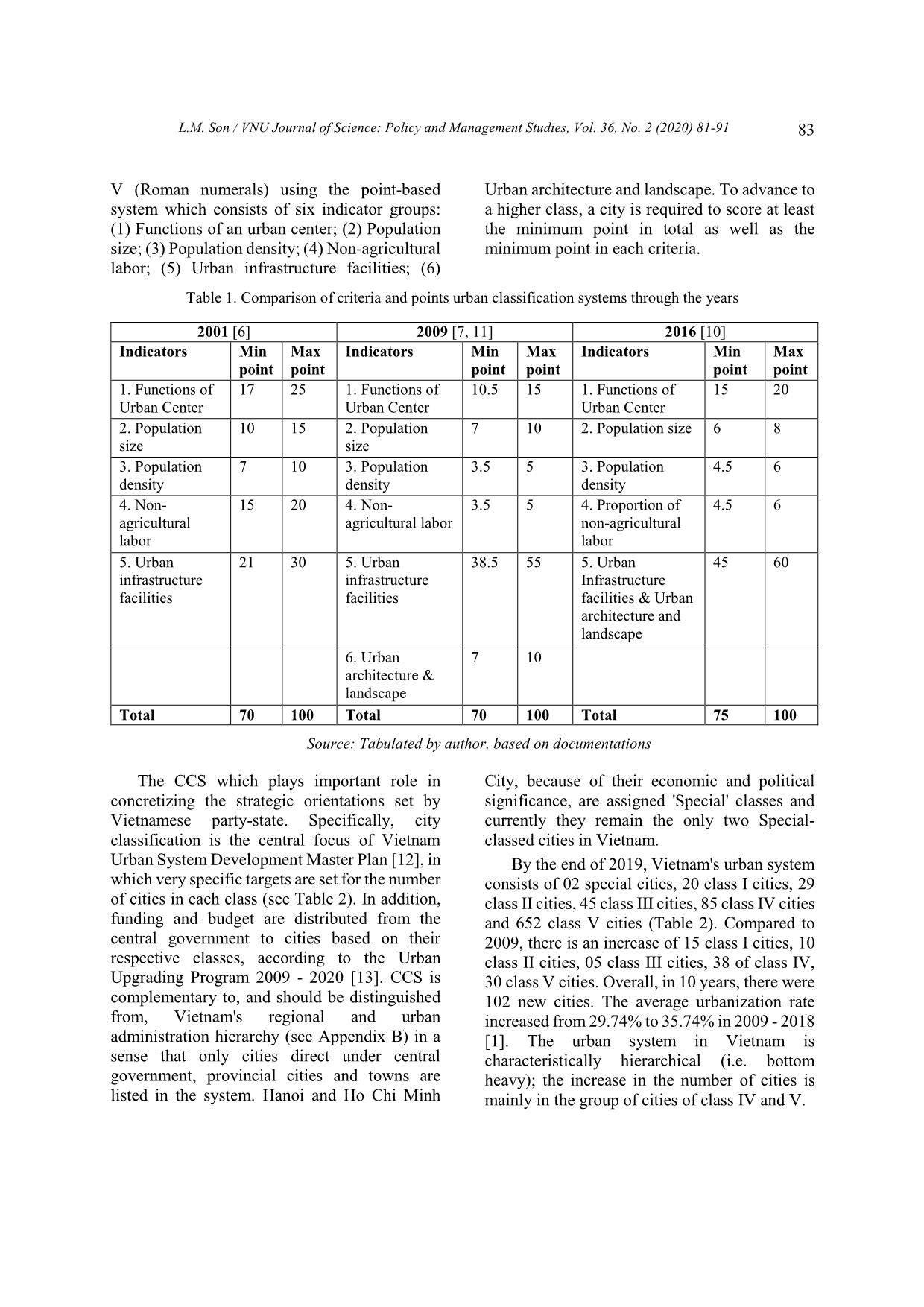
Trang 3
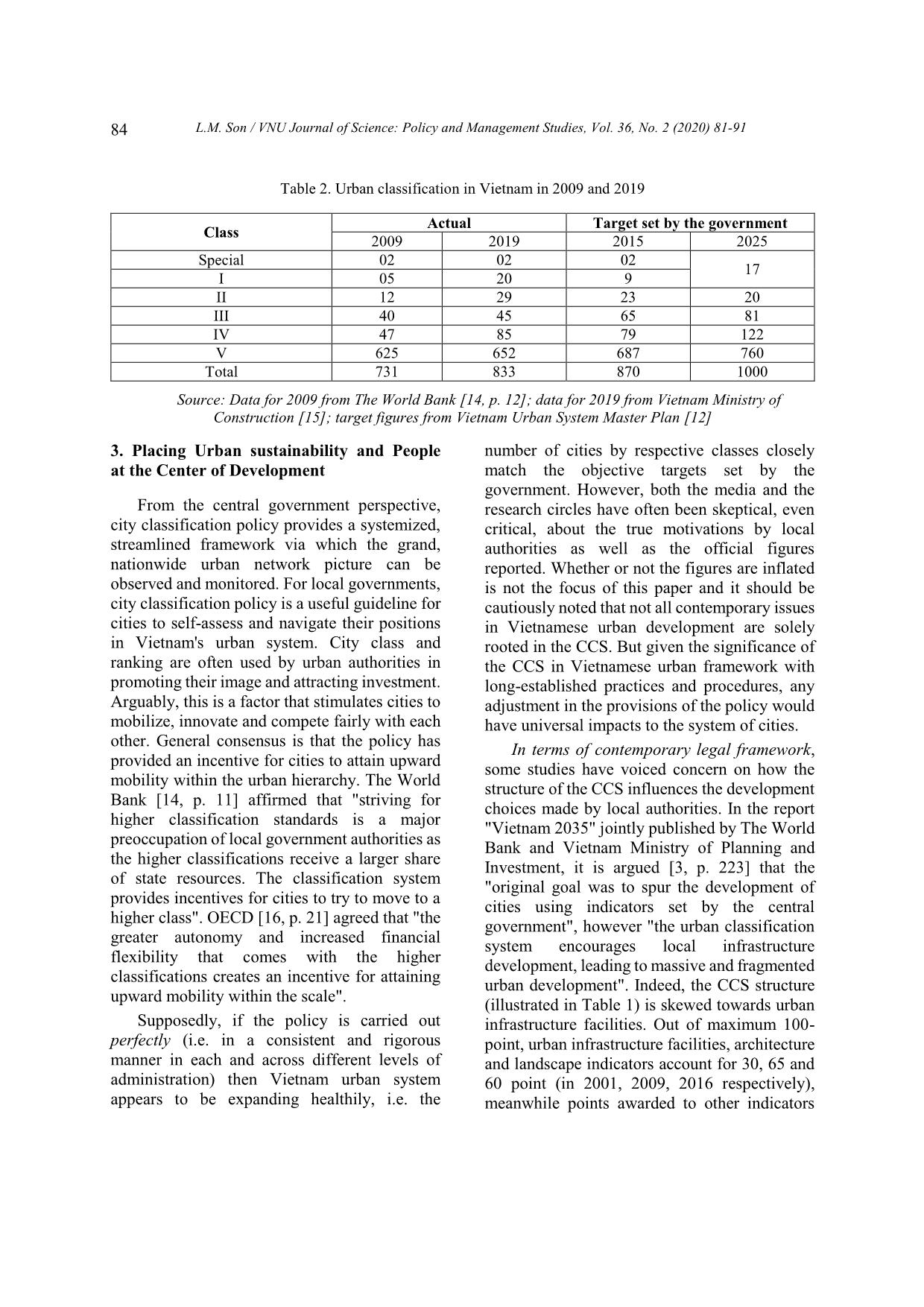
Trang 4
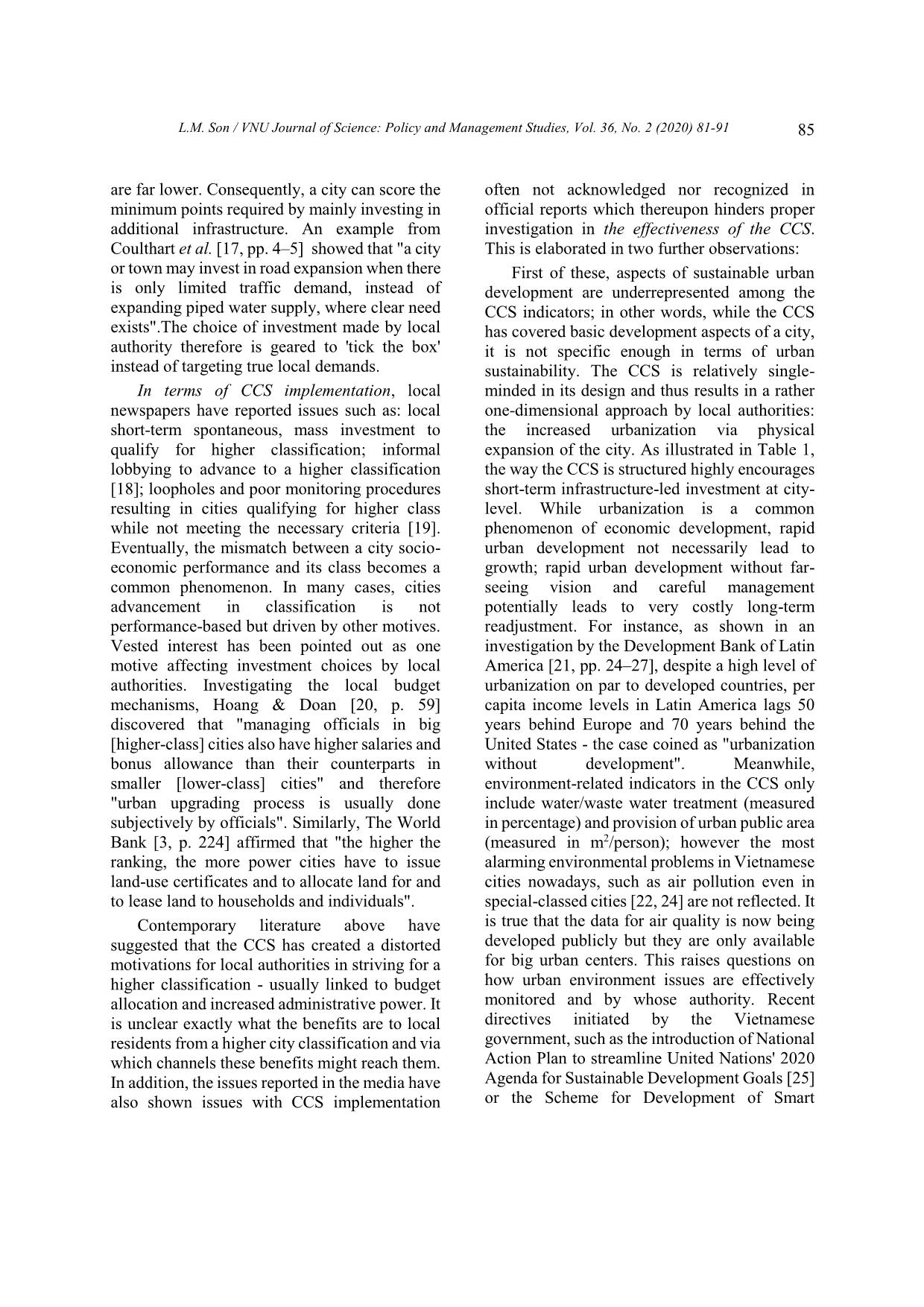
Trang 5
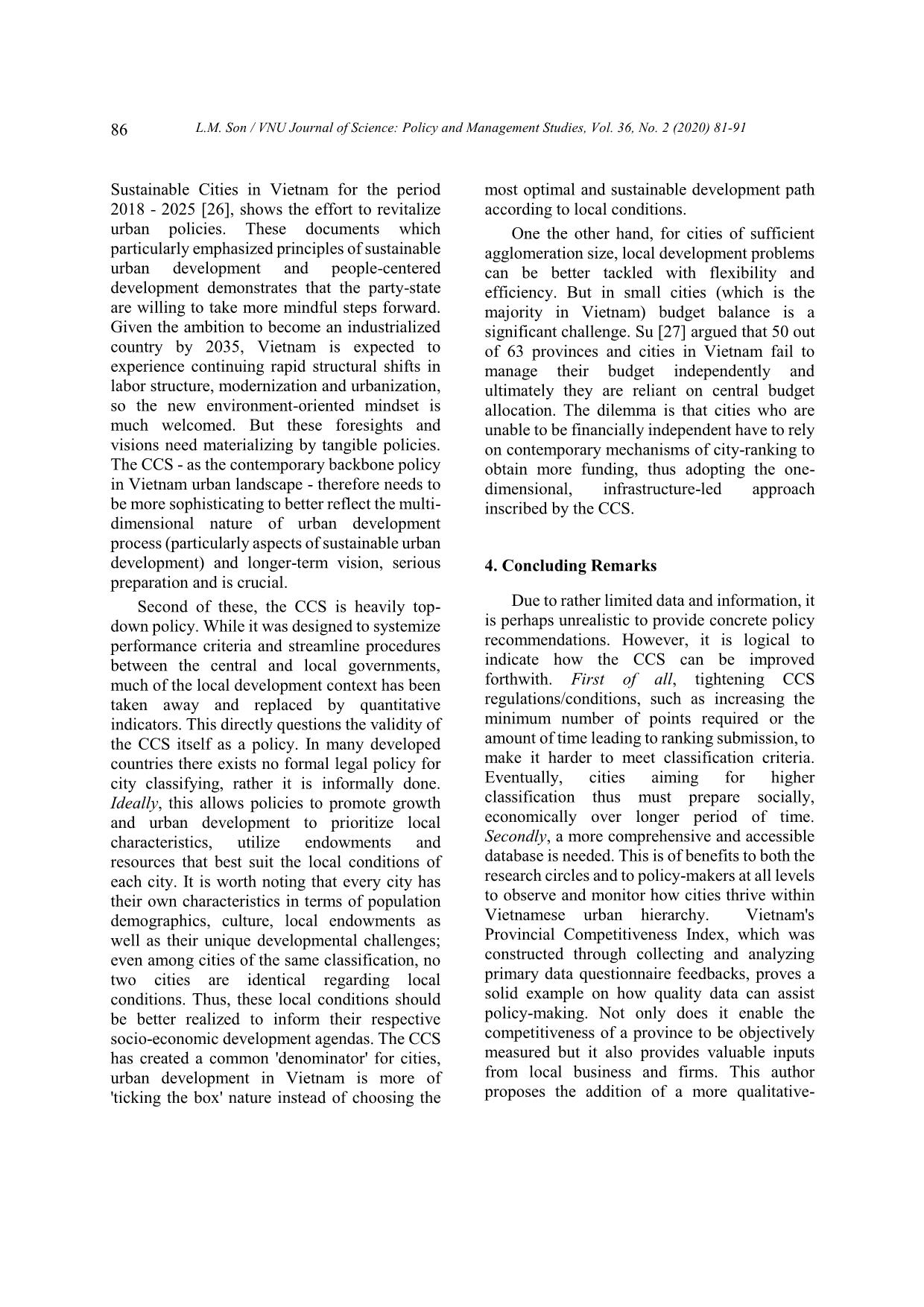
Trang 6
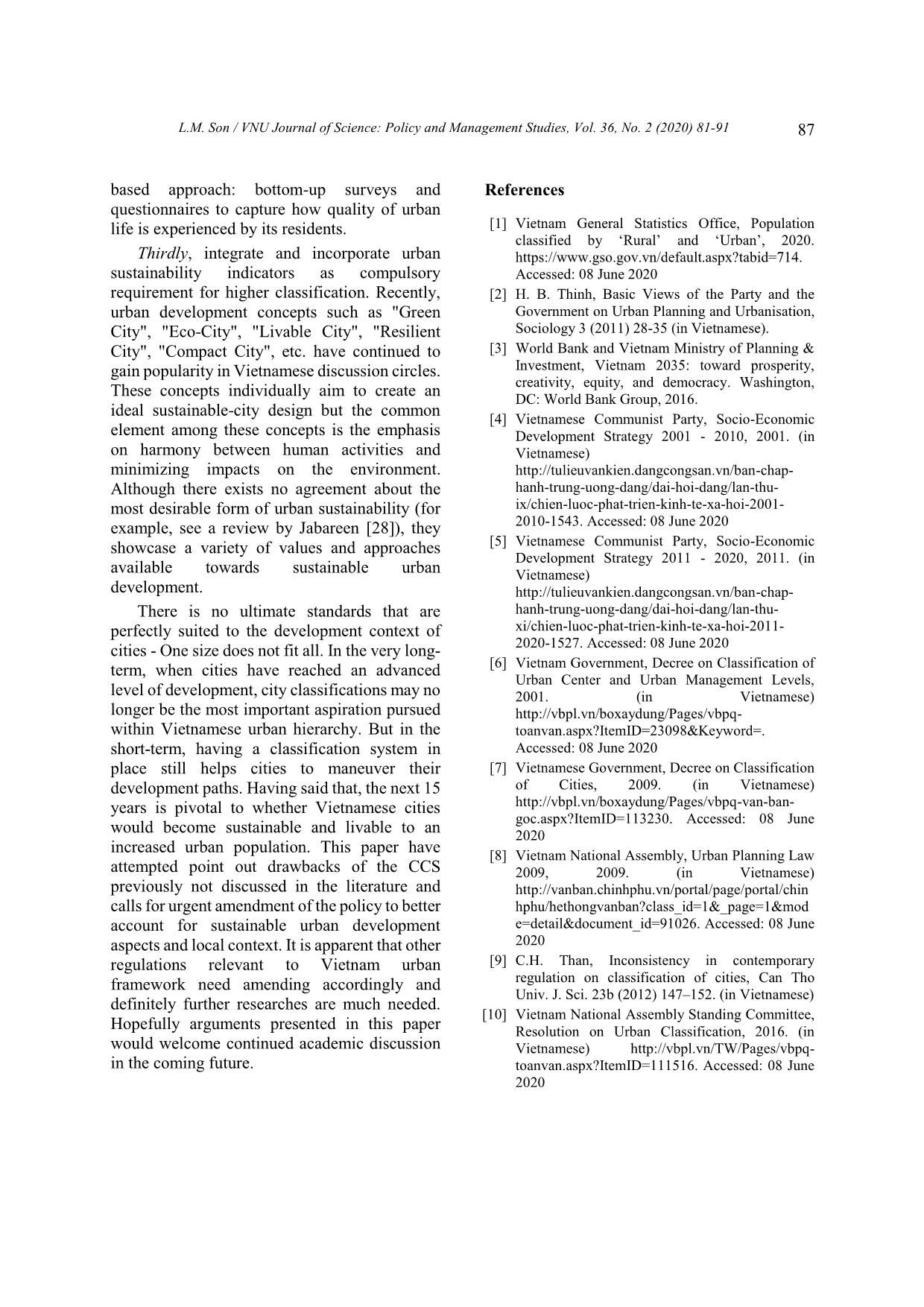
Trang 7
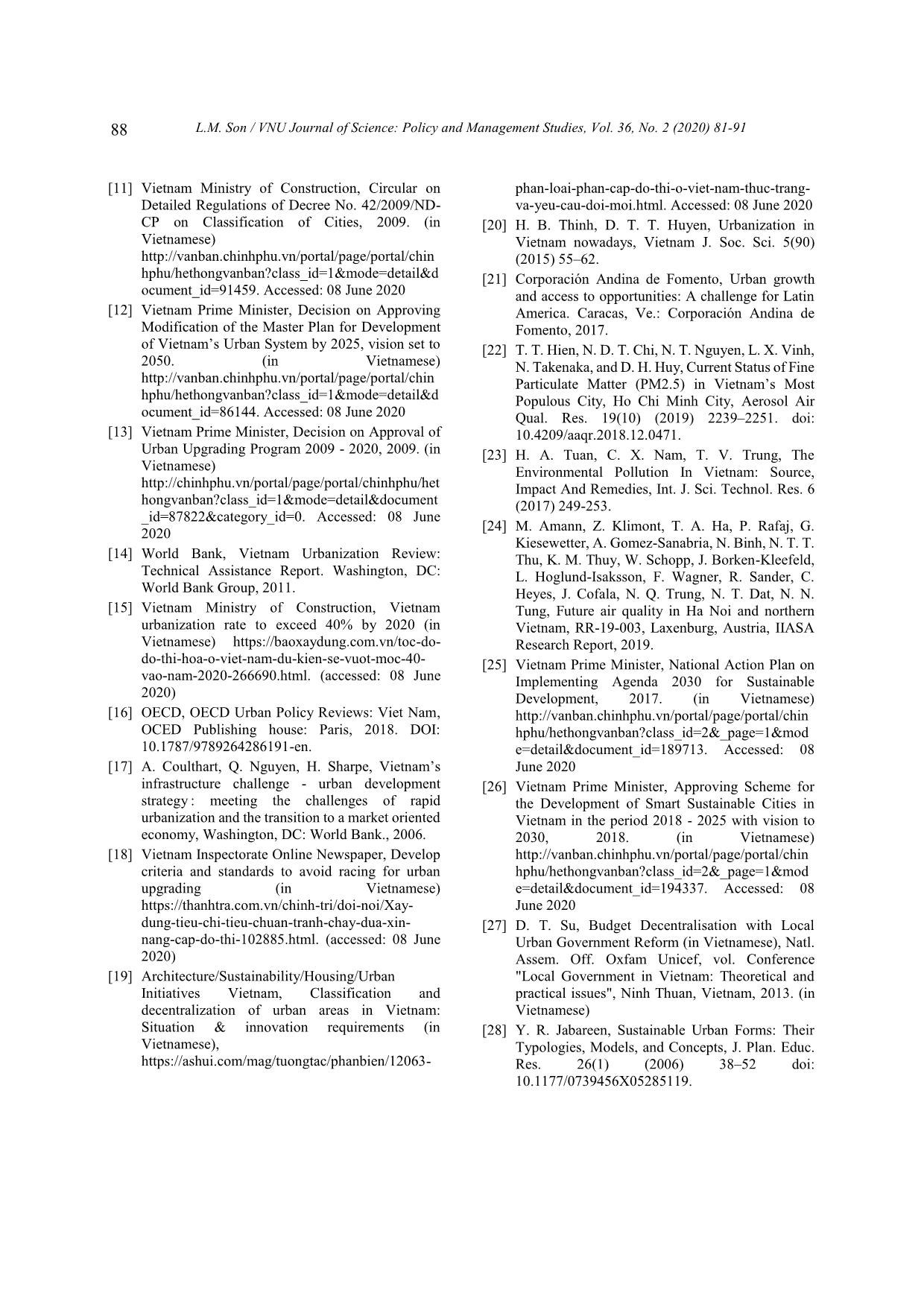
Trang 8
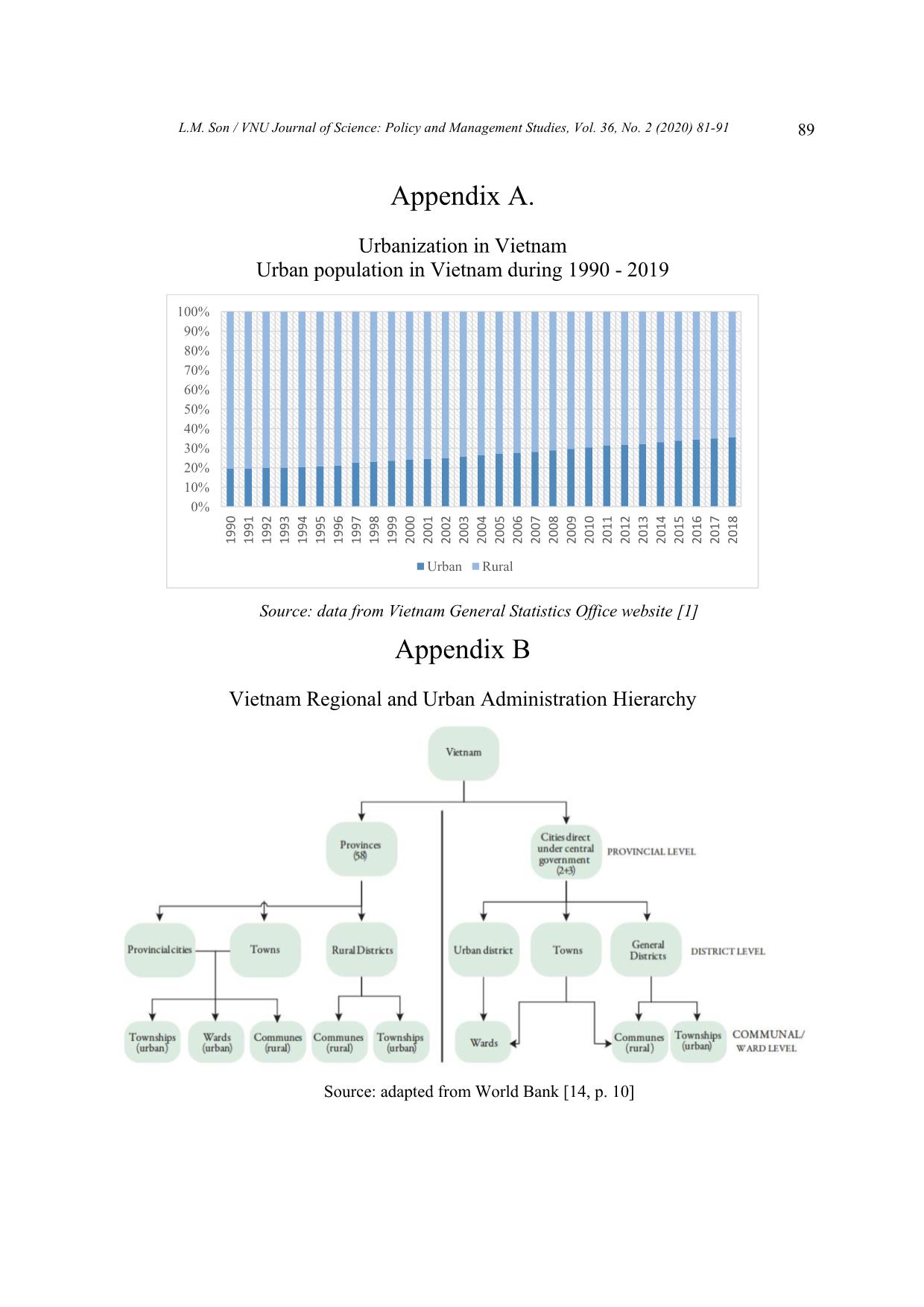
Trang 9
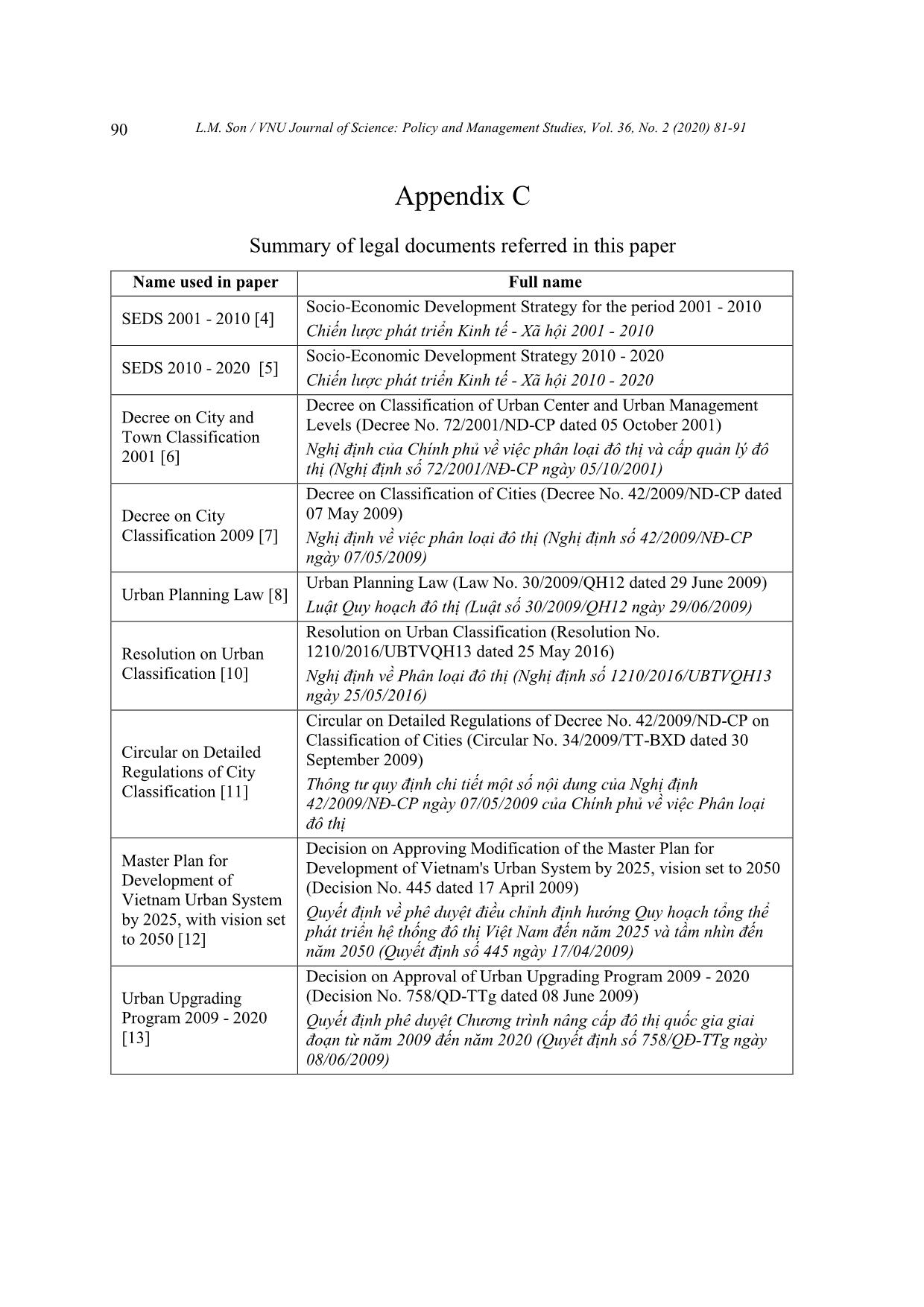
Trang 10
Tải về để xem bản đầy đủ
Tóm tắt nội dung tài liệu: Rethinking City Classification System in Vietnam: Towards Urban Sustainability and People-Centered Development
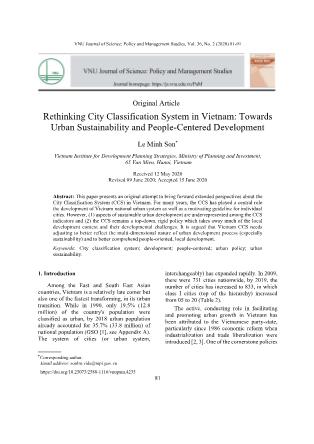
VNU Journal of Science: Policy and Management Studies, Vol. 36, No. 2 (2020) 81-91 81 Original Article Rethinking City Classification System in Vietnam: Towards Urban Sustainability and People-Centered Development Le Minh Son* Vietnam Institute for Development Planning Strategies, Ministry of Planning and Investment, 65 Van Mieu, Hanoi, Vietnam Received 12 May 2020 Revised 09 June 2020; Accepted 15 June 2020 Abstract: This paper presents an original attempt to bring forward extended perspectives about the City Classification System (CCS) in Vietnam. For many years, the CCS has played a central role the development of Vietnam national urban system as well as a motivating guideline for individual cities. However, (1) aspects of sustainable urban development are underrepresented among the CCS indicators and (2) the CCS remains a top-down, rigid policy which takes away much of the local development context and their developmental challenges. It is argued that Vietnam CCS needs adjusting to better reflect the multi-dimensional nature of urban development process (especially sustainability) and to better comprehend people-oriented, local development. Keywords: City classification system; development; people-centered; urban policy; urban sustainability. 1. Introduction Among the East and South East Asian countries, Vietnam is a relatively late comer but also one of the fastest transforming, in its urban transition. While in 1990, only 19.5% (12.8 million) of the country's population were classified as urban, by 2018 urban population already accounted for 35.7% (33.8 million) of national population (GSO [1], see Appendix A). The system of cities (or urban system, ________ Corresponding author. Email address: sonlm.vids@mpi.gov.vn https://doi.org/10.25073/2588-1116/vnupam.4235 interchangeably) has expanded rapidly. In 2009, there were 731 cities nationwide, by 2019, the number of cities has increased to 833, in which class I cities (top of the hierarchy) increased from 05 to 20 (Table 2). The active, conducting role in facilitating and promoting urban growth in Vietnam has been attributed to the Vietnamese party-state, particularly since 1986 economic reform when industrialization and trade liberalization were introduced [2, 3]. One of the cornerstone policies L.M. Son / VNU Journal of Science: Policy and Management Studies, Vol. 36, No. 2 (2020) 81-91 82 in Vietnam urban development picture has been the City Classification System (CCS) which, broadly speaking, aims to categorize Vietnamese cities into 'classes' respective to their socio- economic performance using a set of indicators. The CCS has been a central policy in Vietnam urban development framework, in which it acts both as a monitoring instrument for the central government and as a development guidance for local governments. However, long-term urban issues such as environmental pollution, congestion, social inequity, etc. as well as the ways in which such policy has shaped socio- economic development in Vietnamese cities intrigue questions about its effectiveness and practicality, an area that has cumulated rather scarce and limited research attention so far. This paper thus presents an original attempt to contribute to this literature gap by bringing forward extended views around the CCS. It is argued that firstly, aspects of urban sustainability have often been overlooked in the CCS and secondly, as top-down policy the CCS has often omitted local development context as well as the optimal development paths for cities. Because of the lack of reliable data and access to information, this paper the paper would not go in-depth in analyzing the CCS but instead presents perspectives not yet discussed in current literature. The analysis relies on data and documentations published by the Vietnamese government-state, secondary literature relevant to urban development in Vietnam and, to a lesser extent, information that are available in public domains. The rest of this paper proceeds as follows. Section 2 sketches an overview pictures of the CCS and current status of Vietnam urban system. Section 3 reviews some limitations of the CCS and shows the case to reconsider CCS to better account for sustainability and bottom- up people centric development. The conclusion provides further discussion on urban development and some future policy adjustment. A summary of legal documents referred in this paper is provided in Appendix C. 2. City Classification System and Urban System in Vietnam A review of the socio-economic development strategy (SEDS) documentations shows that the Vietnamese party-state has recognized and repeatedly emphasized the economic role of cities and the urban network as the engine of local and national growth. For instance, in as early as 2001, orientations emphasized: ‘Planning the urban network with a few big cities, many medium cities and small urban systems with reasonable distribution in the regions’ (SEDS 2001 - 2010 [4]). Ten years later, a more specific orientations were given: ‘Step by step forming a system of urban areas with synchronous, modern and environmental friendly infrastructure including some big cities and many small and medium- sized cities linked and rationally distributed across regions’ (SEDS 2011-2020 [5]). To erect and monitor a system of cities as the backbone of national economy requires a comprehensive set of instruments, and thus the CCS was established. Its primary aim is to categorize Vietnamese cities into specific "classes" according to their socio-economic performance using a set of indicators criteria. It was first established in 2001 [6], underwent revision in 2009 [7] and officially put into Law in that same year [8]. Major inconsistent provisions e ... etnam fail to manage their budget independently and ultimately they are reliant on central budget allocation. The dilemma is that cities who are unable to be financially independent have to rely on contemporary mechanisms of city-ranking to obtain more funding, thus adopting the one- dimensional, infrastructure-led approach inscribed by the CCS. 4. Concluding Remarks Due to rather limited data and information, it is perhaps unrealistic to provide concrete policy recommendations. However, it is logical to indicate how the CCS can be improved forthwith. First of all, tightening CCS regulations/conditions, such as increasing the minimum number of points required or the amount of time leading to ranking submission, to make it harder to meet classification criteria. Eventually, cities aiming for higher classification thus must prepare socially, economically over longer period of time. Secondly, a more comprehensive and accessible database is needed. This is of benefits to both the research circles and to policy-makers at all levels to observe and monitor how cities thrive within Vietnamese urban hierarchy. Vietnam's Provincial Competitiveness Index, which was constructed through collecting and analyzing primary data questionnaire feedbacks, proves a solid example on how quality data can assist policy-making. Not only does it enable the competitiveness of a province to be objectively measured but it also provides valuable inputs from local business and firms. This author proposes the addition of a more qualitative- L.M. Son / VNU Journal of Science: Policy and Management Studies, Vol. 36, No. 2 (2020) 81-91 87 based approach: bottom-up surveys and questionnaires to capture how quality of urban life is experienced by its residents. Thirdly, integrate and incorporate urban sustainability indicators as compulsory requirement for higher classification. Recently, urban development concepts such as "Green City", "Eco-City", "Livable City", "Resilient City", "Compact City", etc. have continued to gain popularity in Vietnamese discussion circles. These concepts individually aim to create an ideal sustainable-city design but the common element among these concepts is the emphasis on harmony between human activities and minimizing impacts on the environment. Although there exists no agreement about the most desirable form of urban sustainability (for example, see a review by Jabareen [28]), they showcase a variety of values and approaches available towards sustainable urban development. There is no ultimate standards that are perfectly suited to the development context of cities - One size does not fit all. In the very long- term, when cities have reached an advanced level of development, city classifications may no longer be the most important aspiration pursued within Vietnamese urban hierarchy. But in the short-term, having a classification system in place still helps cities to maneuver their development paths. Having said that, the next 15 years is pivotal to whether Vietnamese cities would become sustainable and livable to an increased urban population. This paper have attempted point out drawbacks of the CCS previously not discussed in the literature and calls for urgent amendment of the policy to better account for sustainable urban development aspects and local context. It is apparent that other regulations relevant to Vietnam urban framework need amending accordingly and definitely further researches are much needed. Hopefully arguments presented in this paper would welcome continued academic discussion in the coming future. References [1] Vietnam General Statistics Office, Population classified by ‘Rural’ and ‘Urban’, 2020. https://www.gso.gov.vn/default.aspx?tabid=714. Accessed: 08 June 2020 [2] H. B. Thinh, Basic Views of the Party and the Government on Urban Planning and Urbanisation, Sociology 3 (2011) 28-35 (in Vietnamese). [3] World Bank and Vietnam Ministry of Planning & Investment, Vietnam 2035: toward prosperity, creativity, equity, and democracy. Washington, DC: World Bank Group, 2016. [4] Vietnamese Communist Party, Socio-Economic Development Strategy 2001 - 2010, 2001. (in Vietnamese) hanh-trung-uong-dang/dai-hoi-dang/lan-thu- ix/chien-luoc-phat-trien-kinh-te-xa-hoi-2001- 2010-1543. Accessed: 08 June 2020 [5] Vietnamese Communist Party, Socio-Economic Development Strategy 2011 - 2020, 2011. (in Vietnamese) hanh-trung-uong-dang/dai-hoi-dang/lan-thu- xi/chien-luoc-phat-trien-kinh-te-xa-hoi-2011- 2020-1527. Accessed: 08 June 2020 [6] Vietnam Government, Decree on Classification of Urban Center and Urban Management Levels, 2001. (in Vietnamese) toanvan.aspx?ItemID=23098&Keyword=. Accessed: 08 June 2020 [7] Vietnamese Government, Decree on Classification of Cities, 2009. (in Vietnamese) goc.aspx?ItemID=113230. Accessed: 08 June 2020 [8] Vietnam National Assembly, Urban Planning Law 2009, 2009. (in Vietnamese) hphu/hethongvanban?class_id=1&_page=1&mod e=detail&document_id=91026. Accessed: 08 June 2020 [9] C.H. Than, Inconsistency in contemporary regulation on classification of cities, Can Tho Univ. J. Sci. 23b (2012) 147–152. (in Vietnamese) [10] Vietnam National Assembly Standing Committee, Resolution on Urban Classification, 2016. (in Vietnamese) toanvan.aspx?ItemID=111516. Accessed: 08 June 2020 L.M. Son / VNU Journal of Science: Policy and Management Studies, Vol. 36, No. 2 (2020) 81-91 88 [11] Vietnam Ministry of Construction, Circular on Detailed Regulations of Decree No. 42/2009/ND- CP on Classification of Cities, 2009. (in Vietnamese) hphu/hethongvanban?class_id=1&mode=detail&d ocument_id=91459. Accessed: 08 June 2020 [12] Vietnam Prime Minister, Decision on Approving Modification of the Master Plan for Development of Vietnam’s Urban System by 2025, vision set to 2050. (in Vietnamese) hphu/hethongvanban?class_id=1&mode=detail&d ocument_id=86144. Accessed: 08 June 2020 [13] Vietnam Prime Minister, Decision on Approval of Urban Upgrading Program 2009 - 2020, 2009. (in Vietnamese) hongvanban?class_id=1&mode=detail&document _id=87822&category_id=0. Accessed: 08 June 2020 [14] World Bank, Vietnam Urbanization Review: Technical Assistance Report. Washington, DC: World Bank Group, 2011. [15] Vietnam Ministry of Construction, Vietnam urbanization rate to exceed 40% by 2020 (in Vietnamese) https://baoxaydung.com.vn/toc-do- do-thi-hoa-o-viet-nam-du-kien-se-vuot-moc-40- vao-nam-2020-266690.html. (accessed: 08 June 2020) [16] OECD, OECD Urban Policy Reviews: Viet Nam, OCED Publishing house: Paris, 2018. DOI: 10.1787/9789264286191-en. [17] A. Coulthart, Q. Nguyen, H. Sharpe, Vietnam’s infrastructure challenge - urban development strategy : meeting the challenges of rapid urbanization and the transition to a market oriented economy, Washington, DC: World Bank., 2006. [18] Vietnam Inspectorate Online Newspaper, Develop criteria and standards to avoid racing for urban upgrading (in Vietnamese) https://thanhtra.com.vn/chinh-tri/doi-noi/Xay- dung-tieu-chi-tieu-chuan-tranh-chay-dua-xin- nang-cap-do-thi-102885.html. (accessed: 08 June 2020) [19] Architecture/Sustainability/Housing/Urban Initiatives Vietnam, Classification and decentralization of urban areas in Vietnam: Situation & innovation requirements (in Vietnamese), https://ashui.com/mag/tuongtac/phanbien/12063- phan-loai-phan-cap-do-thi-o-viet-nam-thuc-trang- va-yeu-cau-doi-moi.html. Accessed: 08 June 2020 [20] H. B. Thinh, D. T. T. Huyen, Urbanization in Vietnam nowadays, Vietnam J. Soc. Sci. 5(90) (2015) 55–62. [21] Corporación Andina de Fomento, Urban growth and access to opportunities: A challenge for Latin America. Caracas, Ve.: Corporación Andina de Fomento, 2017. [22] T. T. Hien, N. D. T. Chi, N. T. Nguyen, L. X. Vinh, N. Takenaka, and D. H. Huy, Current Status of Fine Particulate Matter (PM2.5) in Vietnam’s Most Populous City, Ho Chi Minh City, Aerosol Air Qual. Res. 19(10) (2019) 2239–2251. doi: 10.4209/aaqr.2018.12.0471. [23] H. A. Tuan, C. X. Nam, T. V. Trung, The Environmental Pollution In Vietnam: Source, Impact And Remedies, Int. J. Sci. Technol. Res. 6 (2017) 249-253. [24] M. Amann, Z. Klimont, T. A. Ha, P. Rafaj, G. Kiesewetter, A. Gomez-Sanabria, N. Binh, N. T. T. Thu, K. M. Thuy, W. Schopp, J. Borken-Kleefeld, L. Hoglund-Isaksson, F. Wagner, R. Sander, C. Heyes, J. Cofala, N. Q. Trung, N. T. Dat, N. N. Tung, Future air quality in Ha Noi and northern Vietnam, RR-19-003, Laxenburg, Austria, IIASA Research Report, 2019. [25] Vietnam Prime Minister, National Action Plan on Implementing Agenda 2030 for Sustainable Development, 2017. (in Vietnamese) hphu/hethongvanban?class_id=2&_page=1&mod e=detail&document_id=189713. Accessed: 08 June 2020 [26] Vietnam Prime Minister, Approving Scheme for the Development of Smart Sustainable Cities in Vietnam in the period 2018 - 2025 with vision to 2030, 2018. (in Vietnamese) hphu/hethongvanban?class_id=2&_page=1&mod e=detail&document_id=194337. Accessed: 08 June 2020 [27] D. T. Su, Budget Decentralisation with Local Urban Government Reform (in Vietnamese), Natl. Assem. Off. Oxfam Unicef, vol. Conference "Local Government in Vietnam: Theoretical and practical issues", Ninh Thuan, Vietnam, 2013. (in Vietnamese) [28] Y. R. Jabareen, Sustainable Urban Forms: Their Typologies, Models, and Concepts, J. Plan. Educ. Res. 26(1) (2006) 38–52 doi: 10.1177/0739456X05285119. L.M. Son / VNU Journal of Science: Policy and Management Studies, Vol. 36, No. 2 (2020) 81-91 89 Appendix A. Urbanization in Vietnam Urban population in Vietnam during 1990 - 2019 Source: data from Vietnam General Statistics Office website [1] Appendix B Vietnam Regional and Urban Administration Hierarchy Source: adapted from World Bank [14, p. 10] 0% 10% 20% 30% 40% 50% 60% 70% 80% 90% 100% 1 9 9 0 1 9 9 1 1 9 9 2 1 9 9 3 1 9 9 4 1 9 9 5 1 9 9 6 1 9 9 7 1 9 9 8 1 9 9 9 2 0 0 0 2 0 0 1 2 0 0 2 2 0 0 3 2 0 0 4 2 0 0 5 2 0 0 6 2 0 0 7 2 0 0 8 2 0 0 9 2 0 1 0 2 0 1 1 2 0 1 2 2 0 1 3 2 0 1 4 2 0 1 5 2 0 1 6 2 0 1 7 2 0 1 8 Urban Rural L.M. Son / VNU Journal of Science: Policy and Management Studies, Vol. 36, No. 2 (2020) 81-91 90 Appendix C Summary of legal documents referred in this paper Name used in paper Full name SEDS 2001 - 2010 [4] Socio-Economic Development Strategy for the period 2001 - 2010 Chiến lược phát triển Kinh tế - Xã hội 2001 - 2010 SEDS 2010 - 2020 [5] Socio-Economic Development Strategy 2010 - 2020 Chiến lược phát triển Kinh tế - Xã hội 2010 - 2020 Decree on City and Town Classification 2001 [6] Decree on Classification of Urban Center and Urban Management Levels (Decree No. 72/2001/ND-CP dated 05 October 2001) Nghị định của Chính phủ về việc phân loại đô thị và cấp quản lý đô thị (Nghị định số 72/2001/NĐ-CP ngày 05/10/2001) Decree on City Classification 2009 [7] Decree on Classification of Cities (Decree No. 42/2009/ND-CP dated 07 May 2009) Nghị định về việc phân loại đô thị (Nghị định số 42/2009/NĐ-CP ngày 07/05/2009) Urban Planning Law [8] Urban Planning Law (Law No. 30/2009/QH12 dated 29 June 2009) Luật Quy hoạch đô thị (Luật số 30/2009/QH12 ngày 29/06/2009) Resolution on Urban Classification [10] Resolution on Urban Classification (Resolution No. 1210/2016/UBTVQH13 dated 25 May 2016) Nghị định về Phân loại đô thị (Nghị định số 1210/2016/UBTVQH13 ngày 25/05/2016) Circular on Detailed Regulations of City Classification [11] Circular on Detailed Regulations of Decree No. 42/2009/ND-CP on Classification of Cities (Circular No. 34/2009/TT-BXD dated 30 September 2009) Thông tư quy định chi tiết một số nội dung của Nghị định 42/2009/NĐ-CP ngày 07/05/2009 của Chính phủ về việc Phân loại đô thị Master Plan for Development of Vietnam Urban System by 2025, with vision set to 2050 [12] Decision on Approving Modification of the Master Plan for Development of Vietnam's Urban System by 2025, vision set to 2050 (Decision No. 445 dated 17 April 2009) Quyết định về phê duyệt điều chỉnh định hướng Quy hoạch tổng thể phát triển hệ thống đô thị Việt Nam đến năm 2025 và tầm nhìn đến năm 2050 (Quyết định số 445 ngày 17/04/2009) Urban Upgrading Program 2009 - 2020 [13] Decision on Approval of Urban Upgrading Program 2009 - 2020 (Decision No. 758/QD-TTg dated 08 June 2009) Quyết định phê duyệt Chương trình nâng cấp đô thị quốc gia giai đoạn từ năm 2009 đến năm 2020 (Quyết định số 758/QĐ-TTg ngày 08/06/2009) L.M. Son / VNU Journal of Science: Policy and Management Studies, Vol. 36, No. 2 (2020) 81-91 91 National Action Plan on Implementing Agenda 2030 for Sustainable Development [25] Decision on the Issue of National Action Plan to Implement Agenda 2030 for Sustainable Development (Decision No. 622/QD-TTg dated 10/05/2017) Quyết định về việc ban hành Kế hoạch hành động quốc gia thực hiện Chương trình Nghị sự 2030 vì sự phát triển bền vững (Quyết định số 622/QĐ-TTg ngày 10/05/2017) Scheme for the Development of Smart Sustainable Cities in Vietnam in the period 2018 - 2025 with vision to 2030 [26] Decision on Approval of the Scheme for the Development of Smart Sustainable Cities in Vietnam in the period 2018 - 2025 with vision to 2030 (Decision No. 950/QD-TTg dated 01 August 2018) Quyết định về phê duyệt đề án phát triển đô thị thông minh bền vững Việt Nam giai đoạn 2018 - 2025 và định hướng đến năm 2030 (Quyết định số 950/QĐ-TTg ngày 01/08/2018)
File đính kèm:
 rethinking_city_classification_system_in_vietnam_towards_urb.pdf
rethinking_city_classification_system_in_vietnam_towards_urb.pdf

